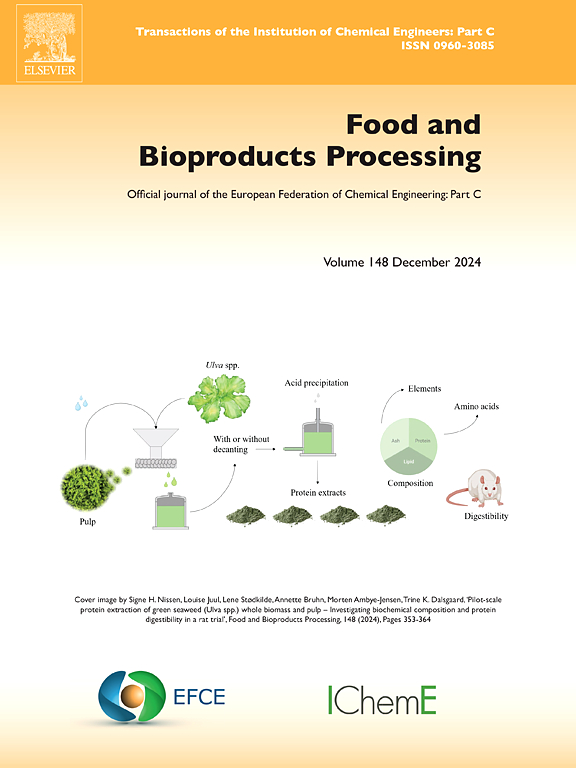Green biosynthesis of silver nanoparticles using anthocyanins-rich extract from Euterpe edulis fruits (AnthocyanOx®): assessment in vitro of antioxidant and antiglycation activities, and in silico anti-aging activity
IF 3.5
2区 农林科学
Q2 BIOTECHNOLOGY & APPLIED MICROBIOLOGY
引用次数: 0
Abstract
The standardized plant extract rich in anthocyanins (approximately 15,000 ppm) extracted from E. edulis fruits (AnthocyanOx®) has demonstrated potential uses and applications for the development of new products in food, cosmetic, and pharmaceutical industries. Anthocyanins provide several health benefits, showing potential to prevent damage and diseases caused by oxidative stress, protein glycation, and premature aging. New formulations enhancing benefits of standardized extract have been developed and green synthesis of metallic nanoparticles have attracted great interest. Techniques such as UV-Visible spectroscopy, Dynamic Light Scattering (DLS), and Scanning Electron Microscopy (SEM) were conducted to characterize silver nanoparticles (AgNPs) synthesized using AnthocyanOx® aqueous extract (EeAE). Antioxidant activity was assessed through DPPH radical scavenging, Ferric Reducing Antioxidant Power (FRAP), ABTS radical scavenging, and Oxygen Radical Absorbance Capacity (ORAC). Molecular docking analyses were conducted to evaluate molecular interactions. The characterization demonstrated AgNPs formation. Antioxidant evaluations showed high antioxidant activity for both EeAE and AgNPs. In silico assays demonstrated that anthocyanins interacted with all enzymes evaluated. These results represent an important indicator for the development and discovery of new nanostructured formulations using standardized extracts rich in anthocyanins extracted from E. edulis for food, cosmetic, and pharmaceutical industries.

利用富含花青素的欧洲果提取物(AnthocyanOx®)绿色生物合成纳米银:体外抗氧化、抗糖化活性和硅抗衰老活性的评估
从edulis果实(AnthocyanOx®)中提取的富含花青素(约15,000 ppm)的标准化植物提取物已经证明了在食品,化妆品和制药行业开发新产品的潜在用途和应用。花青素对健康有多种益处,显示出防止氧化应激、蛋白质糖基化和早衰引起的损伤和疾病的潜力。金属纳米颗粒的绿色合成引起了人们的极大兴趣。采用紫外可见光谱、动态光散射(DLS)和扫描电子显微镜(SEM)等技术对花青素®水提取物(EeAE)合成的银纳米颗粒(AgNPs)进行了表征。通过DPPH自由基清除能力、铁还原抗氧化能力(FRAP)、ABTS自由基清除能力和氧自由基吸收能力(ORAC)来评估抗氧化活性。通过分子对接分析来评价分子间的相互作用。表征表明AgNPs形成。抗氧化评价表明,EeAE和AgNPs均具有较高的抗氧化活性。硅分析表明,花青素与所有评价的酶相互作用。这些结果为利用富含花青素的标准化提取物开发和发现新的纳米结构配方提供了重要的指标,可用于食品、化妆品和制药行业。
本文章由计算机程序翻译,如有差异,请以英文原文为准。
求助全文
约1分钟内获得全文
求助全文
来源期刊

Food and Bioproducts Processing
工程技术-工程:化工
CiteScore
9.70
自引率
4.30%
发文量
115
审稿时长
24 days
期刊介绍:
Official Journal of the European Federation of Chemical Engineering:
Part C
FBP aims to be the principal international journal for publication of high quality, original papers in the branches of engineering and science dedicated to the safe processing of biological products. It is the only journal to exploit the synergy between biotechnology, bioprocessing and food engineering.
Papers showing how research results can be used in engineering design, and accounts of experimental or theoretical research work bringing new perspectives to established principles, highlighting unsolved problems or indicating directions for future research, are particularly welcome. Contributions that deal with new developments in equipment or processes and that can be given quantitative expression are encouraged. The journal is especially interested in papers that extend the boundaries of food and bioproducts processing.
The journal has a strong emphasis on the interface between engineering and food or bioproducts. Papers that are not likely to be published are those:
• Primarily concerned with food formulation
• That use experimental design techniques to obtain response surfaces but gain little insight from them
• That are empirical and ignore established mechanistic models, e.g., empirical drying curves
• That are primarily concerned about sensory evaluation and colour
• Concern the extraction, encapsulation and/or antioxidant activity of a specific biological material without providing insight that could be applied to a similar but different material,
• Containing only chemical analyses of biological materials.
 求助内容:
求助内容: 应助结果提醒方式:
应助结果提醒方式:


